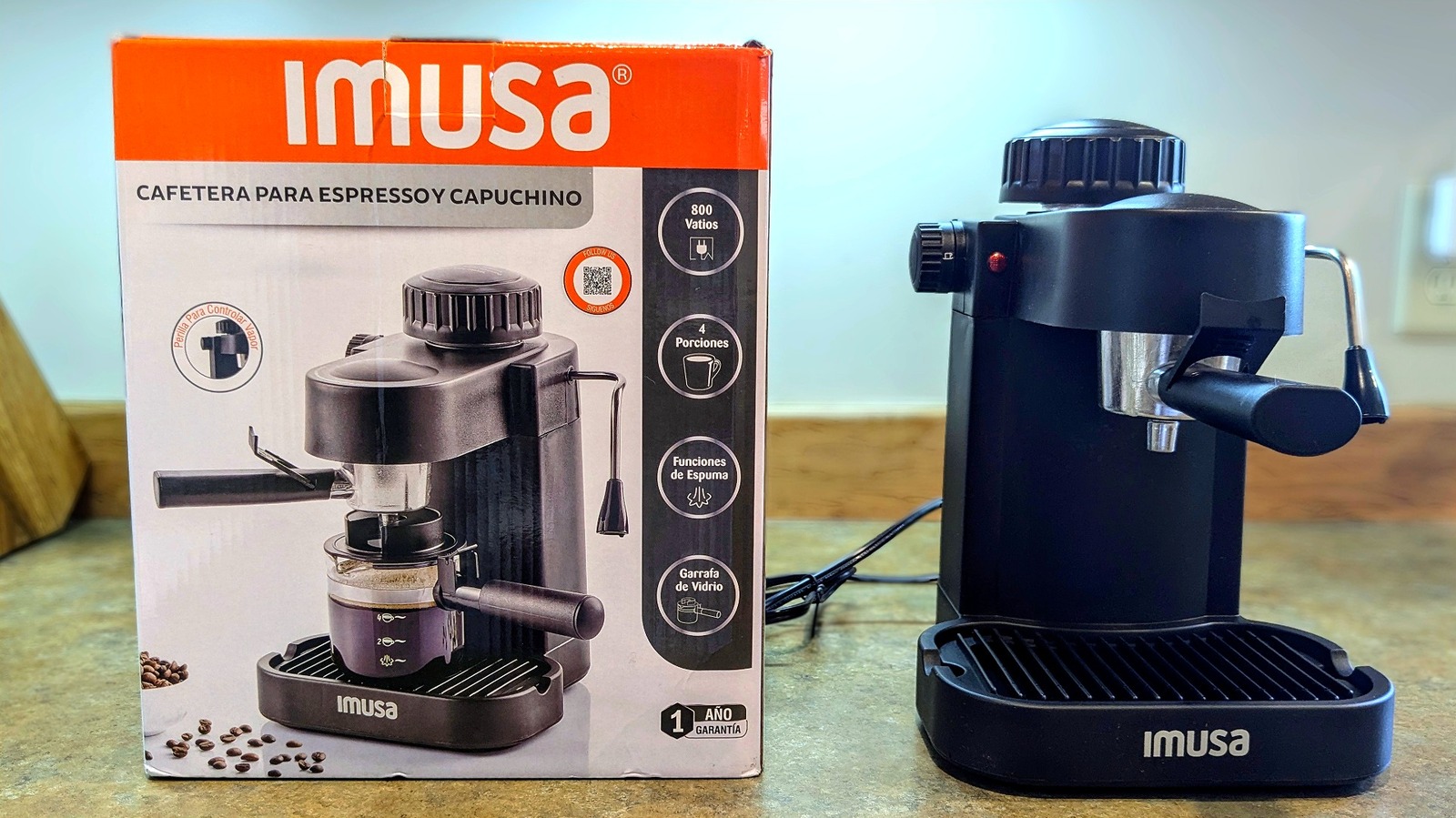We may receive a commission on purchases made from links.
We usually associate espresso with cafés, where we stop on our way to work to grab a shot (or three) for a potent morning wake-up. But sustaining ourselves on café drinks isn’t always economically feasible. That’s where home espresso makers swoop in to save our mornings and our budgets. Sure, advanced espresso machines produce coffee shop-quality drinks, but they aren’t affordable or practical for the average espresso lover: Someone who’s not an aficionado, but not a total coffee novice, either. Most of us just want a decadent, rich coffee topped with luscious crema, free of all the bells and whistles that typically come with an expert machine. Enter budget espresso makers — an increasingly popular option for those looking to ditch drip and change their morning coffee routine.
No matter your initial feelings about a budget espresso machine, you have to admit that they’re pretty tempting. To have the ability to create endless shots for the price of just a few café drinks is like a fantasy come true for the frugal coffee fans. So, in an attempt to shed some light on these ultra-inexpensive espresso makers, I snagged the cheapest possible option available on Amazon (at the time of writing) to put its coffee-crafting capabilities to the test. I’ll examine the set up, functionality, and ease (or difficulty) of use — and, of course, the taste of the coffee it produces. So, let’s find out if this budget Amazon espresso machine is a diamond in the rough, or if it’s just another gimmicky coffee contraption meant to beguile caffeine lovers with its tempting price tag.
What is the IMUSA Espresso and Cappuccino Maker?
As of June, 2025, the IMUSA Espresso and Cappuccino Maker is the most affordable espresso maker on Amazon. It resembles a miniature version of a commercial espresso machine with just one group head (the part of the machine where water meets the coffee grounds). It comes with one portafilter, a plastic measuring spoon, and a glass carafe capable of holding up to four servings of espresso. It also has a small steam wand attached for heating and frothing milk for lattes and cappuccinos.
While the machine is self-described as an espresso machine, it can’t actually make true espresso. The IMUSA relies on steam for brewing, which isn’t capable of producing the amount of pressure necessary to make real espresso. According to the product information page, the IMUSA can produce up to five bars of pressure, but at least nine bars of pressure are required to brew a rich shot with thick, creamy crema. However, stream-driven machines have been known to create a coffee that looks nearly identical to the real thing –to the untrained eye, that is — so this IMUSA product isn’t completely undeserving of its status as an espresso maker just for being steam powered.
Price and availability
I bought the IMUSA espresso machine for $29.99, which included a 25% off from the original price of $39.99, before tax. Compared to what is considered a quality espresso machine of a similar size — like the Breville Bambino — this price sounds a little too good to be true. The Breville and similar name-brand machines of about the same size and capacity as this IMUSA product typically sell for about $300. Meanwhile, generic-brand, budget espresso machines of the same or similar size are often priced around $100.
In addition to Amazon, the IMUSA espresso and cappuccino maker can be found at Target for the same price listed on Amazon, as of June, 2025. I also noticed one gracing the shelves of the coffee gear aisle on my last Walmart run, although it was listed for nearly $50. You’ll likely spot one at Kohl’s as well, where the regular, non-sale price hovers around $55. I was surprised to learn that this machine can even be found on SHEIN – the infamous fast-fashion brand — which proved to be an ominous harbinger of what was to come.
Set up and operation
At first glance, the IMUSA Espresso and Cappuccino maker looks stylish. But after pulling it from the box and setting it on the counter, I was a bit taken aback by its all-plastic, flimsy design. The machine itself is made primarily of plastic, with what looks like aluminum lining the inside of the water reservoir. The portafilter also seemed to be made of aluminium, especially since the area of the filter that houses the basket was deeply scratched before I had even put it to use. This told me that the machine was probably used already, and the soft metal wore away easily.
I ran the machine with some plain water first to clean it out, and then ground up my espresso beans — fine, but not too fine — and filled the filter basket. Despite the scratch marks, I found the tiny, aluminium portafilter cute and charming, until I had to use just about all my strength to force it into place in the group head. I then understood that the scratches on the filter weren’t from carelessness by the previous owner, but rather the insanely frustrating fact that the portafilter doesn’t fit properly into the machine.
It took about five minutes to brew coffee with the IMUSA, and while brewing, steam menacingly billowed out of every orifice in the machine and liquid splattered everywhere. I can’t say for sure, but I would guess that this awkward, plastic contraption couldn’t withstand more than a few months of use before succumbing to the heat that it produces and the brute force needed for it to function.
Taste test: Espresso
For my first coffee test, I brewed four espresso servings, which is the maximum amount of servings that the machine was capable of brewing. After filling the reservoir and securing the coffee-filled portafilter (not without a bit of huffing, puffing, and a few expletives) the coffee dripped through the filter into the carafe — with emphasis on the word drip. It was immediately apparent that the coffee being brewed wasn’t anything remotely close to espresso. Instead of a thin stream of rich, crema-filled espresso cascading like a glorious caffeinated waterfall, the IMUSA produced steady drips of watery, medium-brown liquid that was identical to drip coffee from your average, garden-variety coffee maker. Needless to say, I was crestfallen, but not very surprised.
There was nothing overtly wrong with the flavor of the coffee, but this was thanks to the fresh beans I used and not the machine’s abilities — or, rather, lack thereof. There was no crema to speak of, and although I filled the filter basket up to the maximum capacity and ground my beans fine, the resulting drink was as weak as any coffee from the gas station. Instead of the luscious consistency and almost black color that espresso is known for, this coffee was the color of cardboard that had been left out in the rain. I brewed some more coffee, and then a few more cups of coffee after that, just to make sure that I wasn’t making a mistake while brewing. But, ultimately, I concluded that I wasn’t the problem in this coffee-brewing fiasco.
Taste test: Cappuccino
To make a cappuccino using the IMUSA espresso maker, I had to start the coffee-brewing process, and then turn the dial to the steam setting while the steam wand was inside the milk pitcher. I followed the instructions and started steaming as soon as the brewing started, but it took a while for the steam to really start going. For a few seconds, I was able to froth a decent amount of almond milk, but the steam seemed to be increasing in temperature by the millisecond, so I had to cut it short so my milk wouldn’t bubble over. I wasn’t able to make enough for an extra dry, fluffy cappuccino, but it created enough foam to at least plop a generous dollop on top of the coffee.
Since the coffee wasn’t espresso strength, my drink tasted more like a café au lait or a watery latte than a genuine capp. Although using the steam wand halts the coffee-brewing process — allowing it to start over again once the milk is done frothing — it still managed to make the coffee taste bitter. I imagine the water started boiling in the reservoir, making the water temperature way too high for brewing coffee. Despite burning the coffee, the steam wand functioned much better than the coffee brewing apparatus, by comparison — but that isn’t saying much.
Is the IMUSA Espresso and Cappuccino Maker worth it?
I know the low price is tempting, but the IMUSA espresso maker is far from worth it. Remember being a kid and using the Easy Bake oven, or those little plastic kitchens where you can make pretend, plastic food? That’s what using this machine felt like. I felt like I was making play-espresso, which wasn’t far from the truth, to be honest. At the end of the day, this machine is really just a drip brewer designed to look like an adorable espresso machine — so don’t be fooled by its cuteness.
On top of the weak and sometimes bitter coffee that it produces, there are some serious mechanical concerns with this machine. The plastic and aluminum construction feels hardly stable enough to withstand heat, and the on-off switch is hard to read, with just one subtle light to indicate that it’s still on, making it easy to forget and overlook. Some Amazon reviews claim the IMUSA espresso maker caused electrical fires, with one review even claiming that their house burned down thanks to this dastardly contraption — not worth it for subpar coffee, if you ask me.
Instead of opting for this tenuous, potentially-hazardous, budget coffee maker, choose a moka pot instead for freshly brewed espresso — specifically the Bialetti Moka Express. While this coffee maker also doesn’t technically produce true espresso, (which is typically only attainable via a pricy pump-driven machine), it creates a delicious, worthy substitute for sipping espresso, tasty at-home lattes, or any other drink that you’d typically craft using the real deal.






